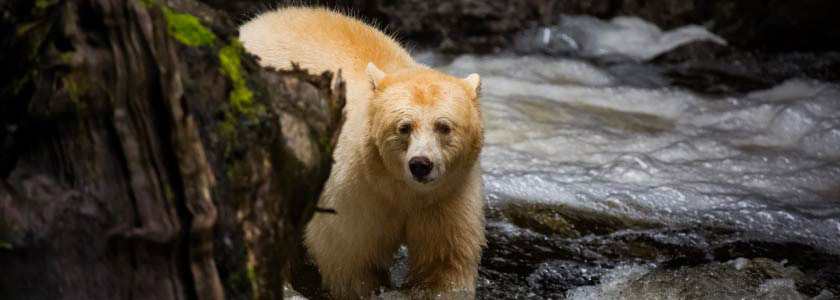Genetic studies suggest Canada’s Kermode Spirit bear gene rarer than previously thought

Along British Columbia’s remote and wild central coast, all-white Spirit bears have long been important animals for local First Nations members.
Oral tradition says that the Spirit bears were created to remind people of the ice age and the hardship that ancestors faced living in an icy, snowy world. For some, spirit bears also symbolize peace and harmony. The bears are so culturally important to groups like the Kitasoo/Xai'xais, Gitga'at, Haíɫzaqv (Heiltsuk), and Wuikinuxv that for years they kept their existence a secret so fur trappers would stay away.
But the Spirit bears of British Columbia are not just any old bears. Today they are the official mammal of British Columbia, and known as the Kermode bear.
How Many Kermode Bears are Left?
The Kermode, Ursus americanus kermodei, is rare subspecies of the black bear, and while most are indeed black their population number is as many as 500 white-colored individuals living in the Great Bear Rainforest. Their presence is economically important to local tribes, with people paying thousands of dollars for short trips that offer the chance to see one.
Are Kermode Spirit Bears Albino?
Genetics has shown that the white variants of spirit bears—actually, “whiteish” may be a more accurate term, as the coat often appears to have a cinnamon tint—are not albinos but instead have pigmented skin and eyes.An early study on the bears in Current Biology found the coloring was due to a Tyr-to-Cys replacement at codon 298 in the white phase in the MC1R gene. That gene is recessive, studies further found, meaning that Kermode bears with two copies of the gene are white while those with one or no copies are black. Further, two black Kermode bears could produce a white cub.
The mutation, reported Smithsonian magazine, likely arose during the last ice age when glaciers draped across the landscape. Cut off from mainland populations, inbreeding among coastal black bears could have increased the mutation’s frequency. The white coloring, further, could help the bears in their hunt for salmon; a 2009 study found that white bears caught more fish, presumably because, to the fish, they blended in with the sky.
Now, a new study in the journal Ecological Solutions and Evidence says that the gene responsible for the spirit bears’ white color is rarer than previously thought and that Canada may need to do more to protect the animals’ habitat.
Because spirit bears are rare and their habitat is a quagmire of coastal rainforest, deep valleys, and deep slushy snow—almost all of it roadless wilderness—scientists guessed that original sampling was inadequate. In the most recent study, researchers noninvasively sampled DNA from the spirit bears using about 100 hair-snagging barbed wires strung around oily piles of odor-enhanced fish fertilizer and placed across broad areas of central coastal British Columbia north and south of the island village of Bella Bella. The wires were evenly spaced every 50 square kilometers and samples were collected every 10 to 14 days.
Researchers found that landscape-level allele frequency was about half that of previous estimates and that there was no statistically significant departure from Hardy-Weinberg equilibrium at MC1R, a finding which could upend previous research into gene flow. They also found that about half of all Spirit bear hotspots were located outside of current protected areas.
“These results provide new insight into hypotheses related to the maintenance of this rare polymorphism, and directly relevant information to support evidence‐based opportunities for Indigenous Nations of the area to attend to gaps in conservation planning,” the authors wrote.
“They could not say whether the finding reflects changes over time, versus different sampling designs,” reported The New York Times. “But it is clear from the new data that the Spirit bear gene variant, while rare, is more widely distributed across the landscape than previously documented. And, by overlaying the geography of the gene’s occurrence with protected areas, the researchers found that many Spirit bear hot spots are not yet adequately protected from habitat loss from logging.”
Protecting the Kermode Spirit Bear
Local communities seeking to further protect the Spirit bears should move fast, the authors added—Pacific salmon, upon which the bears depend for food, are becoming more rare, and grizzly bears, which reduce black bears’ salmon consumption, are moving into the area.
